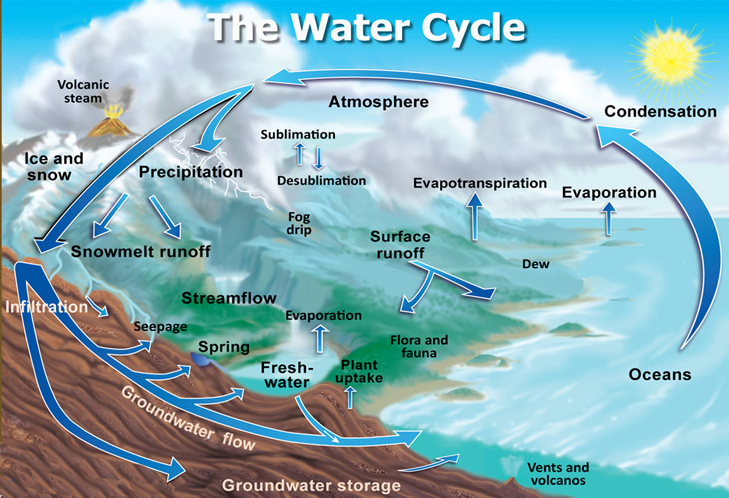HYDROLOGIC CYCLE- MEANING & PROCESSES
MEANING
- The hydrological cycle describes the continuous circulation of water on, above and below the surface of the earth. It means the continuous movement of water between hydrosphere, atmosphere and lithosphere is known as hydrologic cycle or hydrological cycle or water cycle.
- Hydrosphere includes oceans, lakes, rivers and other water bodies on the earth. Oceans alone hold about 96% of earth’s total water; while only 2% as snow and ice; and rest 2% in the water bodies of the continents.
- The partitioning of water on the earth varies according to wide range of climatic variables. The water moves from one reservoir to another, such as from river to ocean, or from the ocean to the atmosphere through physical processes like evaporation, precipitation, condensation, infiltration and surface runoff etc.
- In fact the physical and biological processes in the environment are sustained by hydrologic cycle.
- Water evaporates in form of water vapor through Evapotranspiration. Evaporation means loss of water from soil surface whereas, transpiration means loss of water from plant surface. Water vapor rises above into the atmosphere forms the cloud, when condensation takes place, water precipitates mainly as rain and in some extent as snow or hail.
Thus water is constantly added to the atmosphere through evaporation and is lost through precipitation. - Since oceans occupy 2/3rd of the total surface of the earth, most of the precipitation falls over the ocean.
- About 65% of the total precipitation that falls over continents, returned back to atmosphere through evapotranspiration; while rest finds the way to rivers and oceans as runoff. Thus these processes continue the water cycle, essential for the maintenance of most life and ecosystems on the planet.

PROCESSES & THEIR DEFINITION
- Precipitation- when water vapor transformed into liquid water and falls to the earth surface is called precipitation. Mostly occur as rain, but also in some extent as snow or hail.
- Runoff- it is the excess water from precipitation that finds its way to river and oceans. It can be harvested for subsequent use in agriculture.
- Infiltration– the flow of water from ground surface into the ground and becomes soil moisture.
- Sublimation- the state change directly from solid water (snow or ice) to water vapor by passing the liquid state.
- Advection- the movement of water through the atmosphere. Through advection, water evaporated over the oceans precipitate over the land.
- Condensation- it is reverse of vaporization. It refers to transformation of water vapor to liquid water.
Read more..
ENERGY FLOW OF ECOSYSTEM
TYPES OF THE ECOSYSTEM
WHAT IS ATMOSPHERE- STRUCTURE & LAYERS
WHAT BIODIVERSITY IS-MEANING,TYPES&THREATS
WHAT IS DROUGHT- CAUSE & EFFECTS